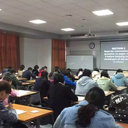Post-treatment follow-up study of abdominal cystic echinococcosis in tibetan communities of northwest Sichuan Province, China.
Nyckelord
Abstrakt
BACKGROUND
Human cystic echinococcosis (CE), caused by the larval stage of Echinococcus granulosus, with the liver as the most frequently affected organ, is known to be highly endemic in Tibetan communities of northwest Sichuan Province. Antiparasitic treatment with albendazole remains the primary choice for the great majority of patients in this resource-poor remote area, though surgery is the most common approach for CE therapy that has the potential to remove cysts and lead to complete cure. The current prospective study aimed to assess the effectiveness of community based use of cyclic albendazole treatment in Tibetan CE cases, and concurrently monitor the changes of serum specific antibody levels during treatment.
RESULTS
Ultrasonography was applied for diagnosis and follow-up of CE cases after cyclic albendazole treatment in Tibetan communities of Sichuan Province during 2006 to 2008, and serum specific IgG antibody levels against Echinococcus granulosus recombinant antigen B in ELISA was concurrently monitored in these cases. A total of 196 CE cases were identified by ultrasound, of which 37 (18.9%) showed evidence of spontaneous healing/involution of hepatic cyst(s) with CE4 or CE5 presentations. Of 49 enrolled CE cases for treatment follow-up, 32.7% (16) were considered to be cured based on B-ultrasound after 6 months to 30 months regular albendazole treatment, 49.0% (24) were improved, 14.3% (7) remained unchanged, and 4.1% (2) became aggravated. In general, patients with CE2 type cysts (daughter cysts present) needed a longer treatment course for cure (26.4 months), compared to cases with CE1 (univesicular cysts) (20.4 months) or CE3 type (detached cyst membrane or partial degeneration of daughter cysts) (9 months). In addition, the curative duration was longer in patients with large (>10 cm) cysts (22.3 months), compared to cases with medium (5-10 cm) cysts (17.3 months) or patients with small (<5 cm) cysts (6 months). At diagnosis, seven (53.8%) of 13 cases with CE1 type cysts without any previous intervention showed negative specific IgG antibody response to E. granulosus recombinant antigen B (rAgB). However, following 3 months to 18 months albendazole therapy, six of these 7 initially seronegative CE1 cases sero-converted to be specific IgG antibody positive, and concurrently ultrasound scan showed that cysts changed to CE3a from CE1 type in all the six CE cases. Two major profiles of serum specific IgG antibody dynamics during albendazole treatment were apparent in CE cases: (i) presenting as initial elevation followed by subsequent decline, or (ii) a persistent decline. Despite a decline, however, specific antibody levels remained positive in most improved or cured CE cases.
CONCLUSIONS
This was the first attempt to follow up community-screened cystic echinococcosis patients after albendazole therapy using ultrasonography and serology in an endemic Tibetan region. Cyclic albendazole treatment proved to be effective in the great majority of CE cases in this resource-poor area, but periodic abdominal ultrasound examination was necessary to guide appropriate treatment. Oral albendazole for over 18 months was more likely to result in CE cure. Poor drug compliance resulted in less good outcomes. Serology with recombinant antigen B could provide additional limited information about the effectiveness of albendazole in CE cases. Post-treatment positive specific IgG antibody seroconversion, in initially seronegative, CE1 patients was considered a good indication for positive therapeutic efficacy of albendazole.


